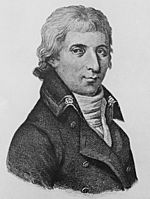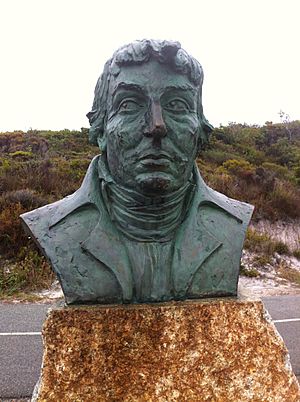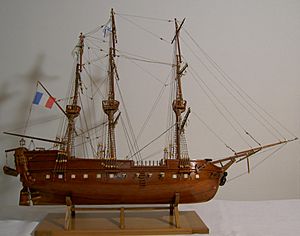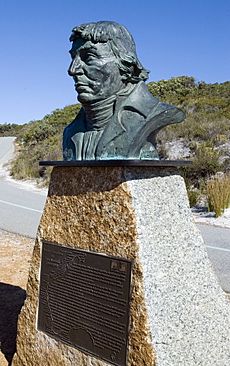Nicolas Baudin facts for kids
Quick facts for kids
Nicolas Baudin
|
|
|---|---|
 |
|
| Born | 17 February 1754 Saint-Martin-de-Ré, Île de Ré, France
|
| Died | 16 September 1803 (aged 49) |
| Nationality | French |
| Occupation | explorer, cartographer, naturalist, hydrographer |
Nicolas Thomas Baudin (born February 17, 1754 – died September 16, 1803) was a French explorer, mapmaker, and scientist. He is famous for his voyages to Australia and other parts of the world, where he discovered many new plants and animals.
Contents
Nicolas Baudin's Early Life and Adventures

Nicolas Baudin was born in Saint-Martin-de-Ré, France, in 1754. He started working on ships at age 15, learning how to sail. When he was 20, he joined the French East India Company. This was a big company that traded with countries far away.
Becoming a Sea Captain
In 1778, Baudin became a second lieutenant on a ship called Lion. This ship was meant to attack enemy vessels. Later, he was moved to another ship, Duc de Choiseul, which was shipwrecked.
Baudin was injured and captured by the British. He was held in Halifax, Canada. But after only a month, he bravely escaped with ten other prisoners. He then hid among friendly communities.
He became a captain of a transport ship, Amphitrite. This ship was also sunk by the English. Baudin was rescued in a small rowing boat. He made his way to Cape Cod and then Boston.
More Voyages and Challenges
As captain of another ship, Revanche, he was captured by the English again. This time, he was taken to Jamaica as a prisoner. Luckily, he was later exchanged and returned to France.
Back home, Baudin became a captain in the French navy. He sailed many merchant ships. At 27, he commanded a large civilian ship called Apollon. He faced more battles at sea. During one trip, his ship, Aimable Eugenie, was attacked by an English ship. Baudin managed to escape, but other ships were captured.
In 1783, his boat sank in Puerto Plata. But he saved the cargo and bought a new ship. He continued to sail, often with his younger brother, Alexandre. They traded goods and explored new places.
In 1786, Baudin sailed to the Isle de France (now Mauritius). On this trip, he met an Austrian botanist, Franz Josef Maerter. He also picked up another botanist, Franz Boos, at the Cape of Good Hope. Baudin helped transport their plant collections back to Europe.
Austrian Expeditions for Science
In 1788, Baudin sailed from Trieste to Canton, China. He used an American flag to avoid problems with Chinese merchants. His ship, Jardinière, later sank near the Northern Mariana Islands.
Baudin bought a new ship, Jardinière II, in Mauritius. But it was destroyed in a big storm. He then traveled on a Spanish ship, Placeres. This ship carried many plant and animal specimens collected for a palace in Austria.
A New Expedition Plan
In 1791, Baudin went to Vienna, Austria. He wanted to lead another expedition to the Indian Ocean and China. He was given the rank of captain in the Imperial navy. A ship, also called Jardinière, was bought for this trip. Two botanists joined him.
The expedition faced delays because of a war between France and Austria. But in October 1792, Jardinière finally set sail. From the Cape of Good Hope, they sailed to Australia. However, two big storms stopped them from exploring. Baudin had to take the ship to Bombay (now Mumbai) for repairs.
From Bombay, the expedition explored the Persian Gulf, the Red Sea, and East Africa. They collected many plant and animal specimens. The journey ended suddenly in 1794 when Jardinière crashed in a storm. Baudin survived and eventually returned to France.
The Caribbean Plant Expedition
In 1796, Baudin suggested a new scientific trip. He wanted to go to the Caribbean to collect plant specimens. The French government and the National Museum of Natural History agreed.
Baudin became the commander of an expedition on a ship called Belle Angélique. Four botanists joined him. They sailed to the Canary Islands, but their ship was not safe enough. They got a new ship, Fanny, and reached Trinidad in 1797.
The British had just taken over Trinidad. They did not let Baudin get his collection of specimens. So, Baudin sailed to other islands like St. Thomas and Puerto Rico. They collected many new plants, birds, and insects there.
The expedition returned to France in 1798. Their large collection was shown in a big parade. Baudin was given a higher rank in the navy.
Exploring New Holland (Australia)

In 1800, Napoleon Bonaparte chose Baudin to lead a big expedition. The goal was to map the coast of New Holland (Australia). Baudin had two ships: Géographe and Naturaliste. Many scientists, including zoologists and botanists, joined him.
They left France in October 1800 and arrived in Australia in May 1801. They explored and mapped the western and southern coasts of the continent. This scientific trip was a huge success! They discovered more than 2,500 new species of plants and animals. The French explorers also met Aboriginal peoples and treated them with respect.
Meeting Matthew Flinders
In April 1802, Baudin met another famous explorer, Matthew Flinders. Flinders was also mapping the Australian coastline. They met in a place now called Encounter Bay in South Australia.
Baudin then stopped at the British colony in Sydney for supplies. From there, he sent the ship Naturaliste back to France. It carried all the amazing specimens they had collected.
Baudin realized his ship, Géographe, could not go into some shallow waters. So, he bought a new, smaller ship called Casuarina. He put Louis de Freycinet in charge of it. Freycinet would later sail around the world himself.
Baudin continued mapping the southern and western coasts of Australia. He then sailed towards Timor. By this time, Baudin was very sick. He decided to head home.
Later Life and Death
Nicolas Baudin died from tuberculosis in Mauritius on September 16, 1803. He was 49 years old. His exact burial place is not known. Some historians believe he was buried in a family tomb. Others think he was buried near the sea, which he loved so much.
In his will, Baudin left his marine watch and telescope to his brother. He also left porcelain and a gold watch to a friend's wife. He asked a judge to take care of his belongings.
Nicolas Baudin's Legacy

Nicolas Baudin's explorations left a lasting mark. In South Australia, several places are named after him:
- Baudin Beach on Kangaroo Island
- Baudin Rocks on the south-east coast
- Nicolas Baudin Island on the west coast of Eyre Peninsula
There are also monuments to him in Australia, especially in Western Australia.
Six animals have been named in his honor:
- Calyptorhynchus baudinii – Baudin's black cockatoo
- Smilisca baudinii – common Mexican tree frog
- Emoia baudini – Baudin's emo skink
- Pseudemoia baudini – Bight Coast skink
- Zanclea baudini – a jellyfish
- Baudin pig – a type of pig once found on Kangaroo Island
Images for kids
See also
 In Spanish: Nicolas Baudin para niños
In Spanish: Nicolas Baudin para niños





